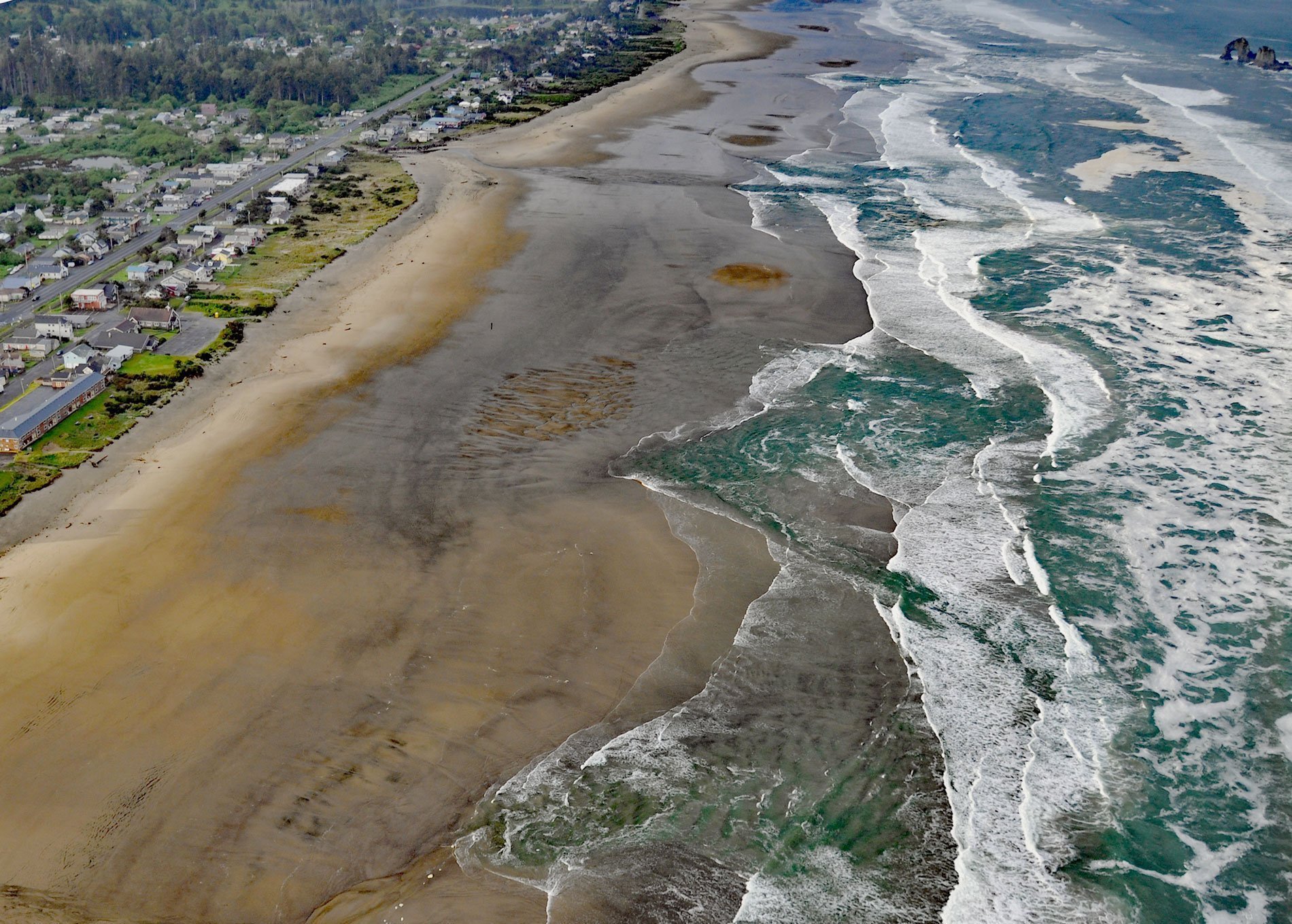Twin Rocks is a set of sea stacks situated about 0.5 miles (0.8 km) offshore and 1 mile (1.6 km) south-southwest of Rockaway Beach, a seaside community on a continuous strand that extends for 6 miles (10 km) from the mouth of the Nehalem River to the north and Tillamook Bay to the south, about 4 miles (6 km) south-southwest of Nedonna Beach and 2 miles (3.2 km) north-northwest of Barview, Oregon. The southern sea stack is a natural arch sometimes called Elephant Head. These islands are part of the Oregon Islands National Wildlife Refuge. The seaside resort of Rockaway Beach was established in 1909 by the Rockaway Beach Company and is named after Rockaway Beach on Long Island in Queens, New York. The communities on Rockaway Beach are situated on a narrow strip of coastal plain formed by a bench or platform eroded by waves from marine sedimentary rock. The western edge of the strip is occupied by dunes that have impounded a series of small lakes. The marine sedimentary rocks are mostly sandstone that formed during the Early Miocene or Oligocene by deposition in deep water. About 15 million years ago, basalt flowed into the northern coastal regions through an ancestral Columbia River drainage. Basalt lava was also erupting from vents near the present-day shoreline and some of the basalt erupted under the sea or poured into it and mixed with the sediment on the sea floor. Basalt was once continuous over a large area along the northern part of the Oregon coast and inland from it and probably was continuous with basalt of the Columbia River Gorge and the Columbia Plateau. Masses of basalt surrounded by less resistant sedimentary rock became isolated from the mainland by wave erosion and only remnants remain, mainly at or near centers of eruption, and where they are located along the shore, they form the prominent headlands and points and the reefs, stacks, and offshore arches.
Native Americans that historically inhabited the area included tribes such as the Tillamook, Nehalem, and Nestucca. These peoples had a close relationship with the sea and area waterways and built boats ranging from small canoes used for duck hunting and fishing on inland rivers and lakes to large ocean-going canoes used for hunting marine mammals and for long-distance travel. In 1788, Captain Robert Gray was the first Euro-American to land and make contact with the Tillamook tribe. The Native population was estimated to be around 2,200 at the turn of the 19th century but declined to one-tenth of that size by the mid-1800s mostly due to European diseases such as smallpox and influenza. The Oregon Country was a disputed region of the Pacific Northwest occupied by British and French Canadian fur traders before 1810. The coastal areas north of the Columbia River were frequented by ships from all nations engaged in the maritime fur trade. The Treaty of 1818 was between the United States and the United Kingdom that allowed for joint occupation and settlement of the Oregon Country, and at the same time established an international boundary between the countries at the 49th parallel. In 1843, settlers established their own government, called the Provisional Government of Oregon, and in 1846, the Oregon Treaty ended the joint occupancy agreement. In 1853, the Oregon territorial government created Tillamook County and the earliest industries were shipping, logging, fishing, farming, and dairy. The Rockaway Beach area remained sparsely populated up until the Pacific Railway and Navigation Company constructed a railway from Portland to Tillamook in 1911 that made the coast more accessible to settlers. The area also became a summer tourist destination as Portland residents began to spend the warmer months on the coast. Men who worked in Portland during the week would take the Friday train to Rockaway to be with their families for the weekend.
Other communities that were established along Rockaway Beach include Nedonna Beach at Nehalem River, Twin Rocks, Watseco, and Barview at Tillamook Bay. Barview was the location of the Tillamook Life Saving Station, which in 1908 was the last station to be built on the Pacific Coast. Due to a change in the coastline in 1915, the station’s boats were housed and moored at Garibaldi in Tillamook Bay. The U.S. Coast Guard continued to use the Barview facility until 1943. Watseco is a community started by the brothers George and Robert Watt who bought 360 acres (150 ha) of beachfront land that became a flag stop for the coastal railroad in 1916. The name is a combination of ‘Watt’ and ‘Sea Coast’. The community of Twin Rocks is the home of Twin Rocks Friends Camp founded in 1918 as a religious retreat. Nedonna Beach is the terminus of three undersea communication cables including the Trans-Pacific Express, Southern Cross Cable, and NorthStar Cable connecting Oregon with Alaska. Early residents of these communities most likely participated in the commercial fishing industry at the nearby ports of Garibaldi and Nehalem; however, both sport and commercial fishing have become severely limited. Rockaway Beach is becoming increasingly known as a vacation and retirement community, with 50 percent of its households used seasonally. Read more here and here. Explore more of Twin Rocks and Rockaway Beach here:

